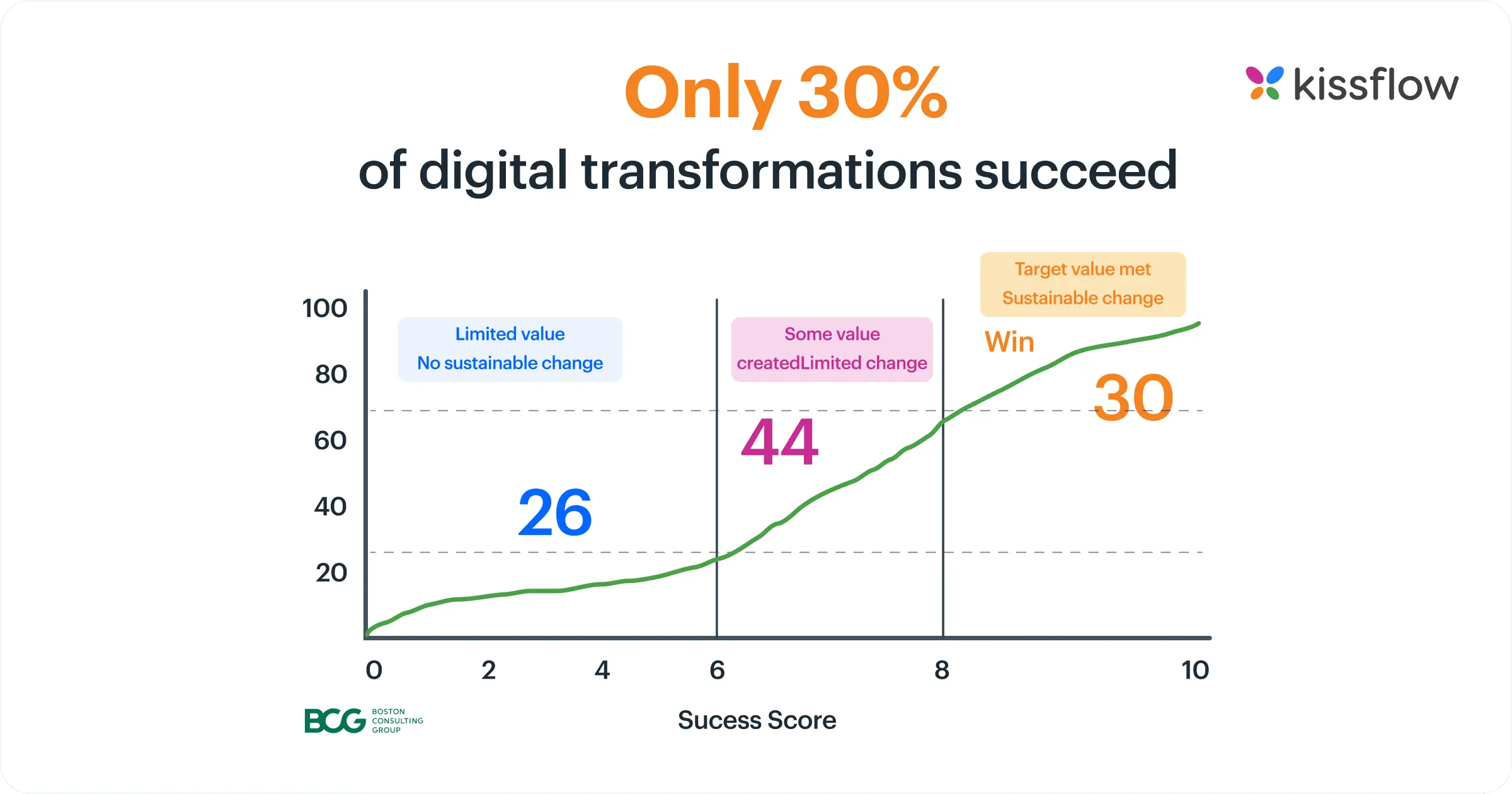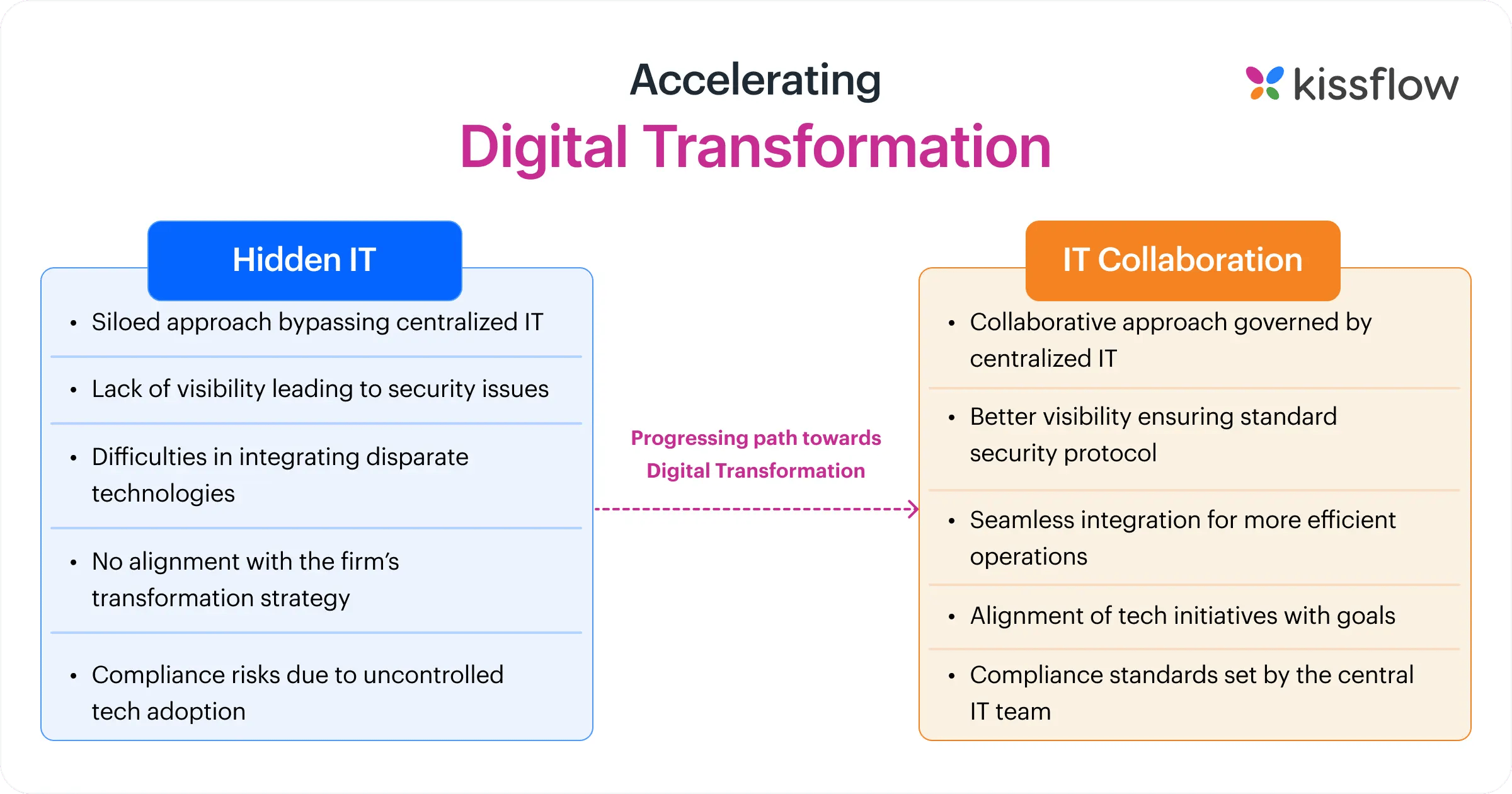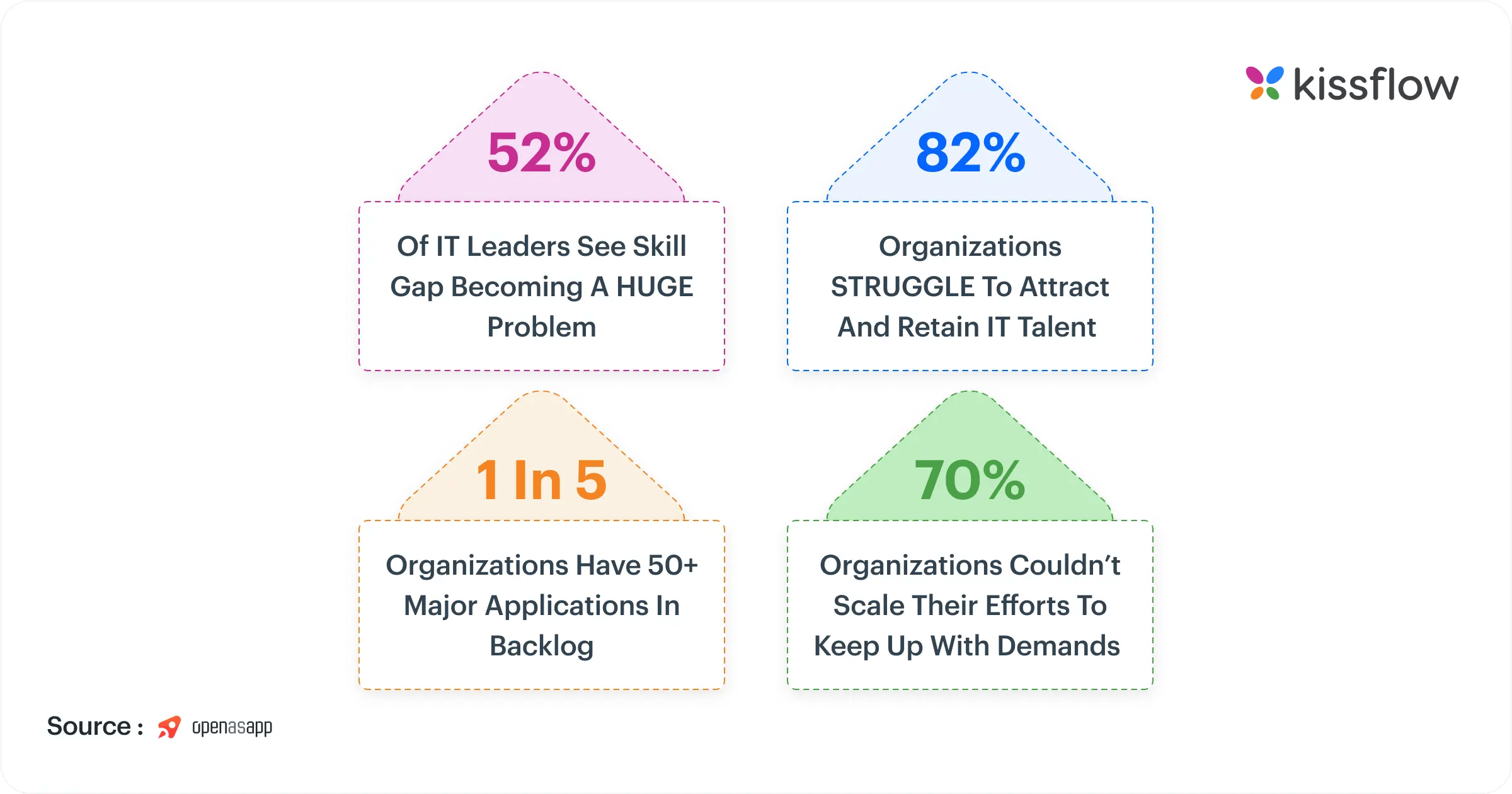
- >
- Featured >
- Take Digital Transformation From a Crawl to a Sprint
Take Digital Transformation From a Crawl to a Sprint
Digital transformation has been a buzzword for a while now—and with good reason. It makes the difference between business success and failure. During COVID-19, organizations that had embarked on digital transformation continued to operate and remained productive throughout the extremely challenging period.
Dell’s Digital Transformation Index 2020 revealed that eight out of ten organizations fast-tracked their digital transformation initiatives in 2020. The pandemic highlighted the need for a more agile and scalable IT environment.
However, fast-tracking digital transformation requires a well-planned strategy and tools to significantly scale digitization.
Let's look at how low-code can take digital transformation from a crawl to a sprint.
The Importance of Digital Transformation
The biggest reason organizations embark on digital transformation is to survive and succeed. Companies that adapt quickly to time-to-market pressures, supply chain disruptions, and rapidly changing customer expectations become market leaders. They use new technologies to drive lasting change.
Digital transformation has become essential for companies that want to remain competitive in today’s ever-changing business landscape. In recent years, there’s been rapid transformation in the business world. Many organizations have adopted new technologies to streamline operations and improve their bottom line.
But digital transformation isn’t easy. According to a research study by the Boston Consulting Group, only 30 percent of transformations result in sustainable change. 44 percent result in limited long-term change, and 26 percent produce no sustainable change at all.

Many digital transformation initiatives fail because organizations aren’t wholly prepared for change. Digital transformation isn’t just about investing capital; it’s about developing strategies, involving stakeholders, and addressing the challenges and opportunities it brings. While it makes a company innovative, it is disruptive. As a result, it’s important to consider your industry’s changing landscape and business needs when choosing a digital transformation solution.
Challenges in Digital Transformation
No Clear Strategy
Without digital transformation goals and a shared vision, an organization will navigate blindly. A well-defined strategy ensures alignment across the organization.
First, develop a problem statement to align stakeholders on solving high-priority issues. By adopting a strategic approach, prioritizing areas of impact, embracing agility, and investing in training and development, a company can successfully undergo digital transformation and unlock new opportunities for growth and innovation.
Failure to Manage Stakeholder Expectations
Considering stakeholders' wants and needs while undergoing a digital transformation is important. Effectively managing expectations lets you proactively address concerns and manage resistance. Engage stakeholders early to understand their perspectives, identify potential issues, and tailor change management strategies accordingly.
Integration Challenges
In 2022, companies worldwide were using an average of 130 SaaS applications. However, the percentage of connected applications still remains low. Most IT decision-makers find it hard to introduce new technologies or update existing applications because of their company’s IT infrastructure. Most say that integration challenges are slowing digital transformation progress.
An integrated IT architecture resolves integration challenges and provides enterprises access to real-time data for making better and more informed business decisions. It manages multiple systems and their individual data stores on one platform and reallocates valuable resources to other areas of operation.
Internal Resistance to Change
Training employees to use new tools is hard enough, add change resistance to the mix, and digital transformation begins to look impossible. Employees often resist change because they don’t know what is expected of them or think new technologies will replace them.
Manage this resistance by providing clarity on what will change and the expected results. Change management can help a company prepare employees for what lies ahead. Don’t just focus on the technical side of digital transformation; consider the people it will affect and develop a comprehensive change management plan.
Scope Creep
Unplanned changes or additions often affect the cost, schedule, and deliverables of digital transformation initiatives. Without a strategy, you’ll make decisions that increase your budget but offer little to no benefit.
Consider the long-term goals of digital transformation and use them to develop a realistic plan. Make sure you understand the digital solutions you’re implementing, monitor the project, and have clear change request procedures to ensure your project aligns with the original goals.
Budgets and Security Constraints
Another hindrance to successful digital transformation is the budget. You can't stick to your budget when you don’t have a clear-cut strategy. Creating a digital transformation strategy that fits your budget and meets your security needs is crucial.
Technology Choices
Choosing the wrong technologies for your organization can be a costly mistake. You need to get the technological choices right the first time.
The solution you get should help you tear down silos and hierarchies and replace them with collaborative cross-departmental teams empowered to work on new ideas rapidly. It should integrate well with other business systems, allowing you to scale easily.
Hidden IT vs. IT Collaboration: Bring hidden IT Out of the Shadows
According to IDC, the global shortage of developers will increase to 2.8 million by late 2023. Developers are in short supply, but the demand for them keeps rising. In 2023 alone, 750 million applications are needed to meet enterprise demand. IT teams are required to deliver more applications year after year, but most are overwhelmed and can’t meet the demand for diverse technological needs, resulting in shadow IT.

Employees who feel IT takes too long to deliver solutions use systems, software, and applications without explicit IT approval, putting their organizations at risk. Some employees resort to shadow IT because they need specialized applications they feel IT can’t build.
Departments wanting more control over their technology budgets may get tools that allow them to allocate funds according to their priorities. But, using solutions not governed by IT exposes a business to compliance risk and cyber attacks.
While shadow IT makes it easier for employees to do their jobs, it also makes it harder for IT to do theirs. In addition, organizations do not have a single source of truth when it comes to data. Data analysis and reporting may be inaccurate, leading to compliance issues. Siloed systems are also harder to integrate and align with a firm’s digital transformation strategy.
IT-Business Collaboration is the Answer
Teamwork makes the dream work. A past McKinsey survey found that companies with winning transformations focus on talent more than anything else. IT and business teams must be willing to work together and use digital tools for a common goal.
When digital transformation is governed by democratized IT, there’s better visibility into processes, which ensures standards are followed. Integrating systems and aligning technology initiatives with business goals is also easier.
To succeed in digital transformation, enterprises must rethink the way they operate. Business and IT teams must collaborate to share accountability for transformation outcomes. Bring hidden IT out of the shadows by offering a solution to non-technical employees who want to pursue their own technology initiatives. Democratizing IT leads to faster innovation, optimized products and services, and greater opportunities for ROI.
The Digital Transformation Curve
Rogers' Innovation Adoption Curve indicates that people can be categorized into five segments based on how they react to a new product: innovators, early adopters, early majority, late majority, and laggards. These segments are based on people’s aversion to risk and readiness to adopt a specific innovation.
Innovators and early adopters are the most important people in adopting an innovation. They make up 16 percent and use new technology before the majority of people. They have a strong influence on the success or failure of new technology.
Let’s put this into perspective. Almost 75 percent of global organizations cited digital transformation as their leading IT priority in 2022, but only 7 percent have fully implemented digital transformation. Many are still in the development stage.
To fully implement digital transformation, companies can no longer afford to focus on the late majority and laggards. They must focus on the innovators and early adopters. They must support innovation and empower departments to collaborate to reach target business outcomes.
Accelerating Digital Transformation with Low-Code
Have you ever wondered how some businesses transform quickly to keep up with changing times? The secret is low-code—a game-changer in the world of digital transformation.
Traditional development methods can’t help organizations digitize at scale. That’s where low-code comes in. The application development technology delivers faster and more efficient results, making it an ideal solution for various digital initiatives, including Nearshore Software Development
Digital transformation strategies cover many spheres. Employees must be trained, IT must collaborate with businesses to ensure data security and cost-effectiveness, and apps must be developed rapidly.
Low-code is the answer. The software creation approach allows developers and non-developers to create applications using visual design tools and pre-built components. Low-code platforms significantly reduce the amount of manual coding required and accelerate application development.
See how low-code technology can fastrack your digital transformation journey
What Challenges Drive Organizations to Adopt Low-Code?
Slow Software Delivery
Traditional development is both costly and time-consuming. Building custom applications can take anywhere between a couple of months to a year. As a result, many of the projects get put on the back burner, affecting digital transformation timelines. Leveraging software delivery intelligence platforms like Axify can provide critical insights into the development process, including performance metrics, efficiency, and areas for improvement.
With low-code development, you ship apps faster and with comparatively smaller budgets. Low-code platforms can decrease the development time by up to 90% by including business users and domain experts in the development process.
Low Talent Retention
The global IT skills gap is increasing at an alarming rate. Finding talented IT specialists is difficult as competition for them is fierce. When IT professionals lack the right skills, projects take longer, app-building costs increase, and business objectives aren’t met.
Low-code can reduce the skills shortage by empowering business users to develop complex enterprise solutions without little to no coding. It becomes possible to ship applications in weeks instead of months.
Application Backlog
As companies undergo a digital transformation, they need new and updated applications with better features and capabilities. But most companies are resource-constrained, and IT professionals who can build such software already have too much on their hands. As demand for new solutions to accelerate digital transformation keeps increasing, IT professionals are getting overstretched and in danger of burning out.
IT teams in most companies have 50 apps (on average) in their backlog. So, they only focus on the most pressing projects. When freed of simple application development, IT teams can use the time to design applications that require their expertise.
Low-code can significantly decrease application backlog with faster development times, reusable templates, and by even allowing business users to build applications.
Inability to Scale
Traditional application development is a slow process with lengthy planning and design phases. Once development has begun, changing the requirements or design is difficult.
Low-code tools are adaptable and allow businesses to manage changing requirements and demands effectively. Users can easily modify or update applications developed on low-code platforms and stay agile in a constantly evolving market.
Low-code platforms can be used to develop simple applications or complex enterprise systems. They have a wide range of built-in features and integrations that make this possible. And regardless of how low-code apps are built, users can reduce complexity to improve performance, scalability, and speed of innovation.
Users at all development skill levels—pro developers, business stakeholders, and subject matter experts—can use low-code to develop functional enterprise applications. Non-developers can use no-code to easily create simpler applications like landing pages, forms, dynamic websites, and other internal web-based applications.
Supercharging Digital Transformation with Kissflow
Kissflow Low-Code offers all the coding capabilities, customizations, and functionalities of a low-code app-building environment and the simplicity and scalability of a no-code platform. We don’t make app development complex, extend development cycles, or complicate maintenance processes. Apps built on our platform are easier to use, cheaper to maintain, and have a faster time-to-market.
Kissflow also makes it easier to govern apps with complete visibility, all the while encouraging innovation. Get Kissflow today and accelerate your enterprise app development. Empower non-technical users to create applications.
To find out where you are in the digital transformation journey, use our Digital Transformation assessment tool. It comprehensively reviews your organization's current digital capabilities and shows how they stack up against your desired technology goals. You can also visit our events page to see our upcoming webinars.

Vinitha Ramani
AVP of Kissflow
Vinitha is an ABM, Corporate Communications, and Digital Marketing expert at Kissflow. She is crucial in enhancing the low-code platform's market presence through strategic storytelling that connects product innovations with sales and customer needs.
Vinitha is an ABM, Corporate Communications, and Digital Marketing expert at Kissflow. She is crucial in enhancing the low-code platform's market presence through strategic storytelling that connects product innovations with sales and customer needs.
Related Articles













